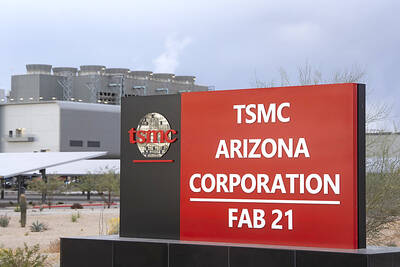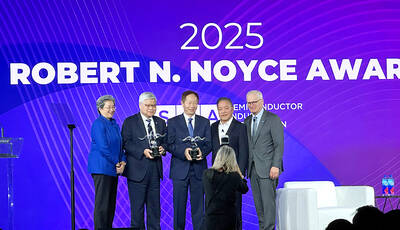Taiwan’s once-booming textile industry entered this decade in need of a wake-up call, with global competition having reduced exports by more than a third. However, one firm has received a boost from a surprising source: coffee.
The S. Cafe fabric, made by Singtex Industrial Co (興采實業), incorporates recycled coffee grounds from Starbucks and 7-Eleven, and has proved to be a hit with heavyweight international brands including Nike and North Face.
Industry figures say the fiber — more than three years in development and sold under the slogan “Drink it, wear it” — shows how the sector might reinvent itself as green, savvy and even cool.

Photo: AFP, Patrick Lin
“S. Cafe fiber marks a technological breakthrough in the company’s research and development,” said Jason Chen (陳國欽), the company’s 50-year-old chairman, who drinks four cups of coffee a day.
The nation’s textile exports peaked in 1997 with a value of US$16.7 billion, but since then overseas shipments have been declining, as wages have gone up while tough and nimble rivals have emerged in China.
Partly because of the global financial crisis, exports hit a nadir of US$9.4 billion in 2009, according to figures compiled by Taiwan Textile Research Institute (紡織產業綜合研究所), a semi-official industry research unit.
Yet Frank Hsu (許文正), deputy secretary-general of the Taiwan Textile Federation (台灣紡拓會), says this is not the end of the story.
“The textile industry is by no means a ‘sunset industry,’” he said. “Rather, the sun is right above our heads.”
The textile sector, in which 4,000 companies now employ about 190,000 workers, needs a renaissance, but it may not be easy — and it definitely will not be cheap.
Singtex spent NT$50 million (US$1.7 million), or about a third of its capital, to develop its new fabric, about 2 percent of which is coffee extracts, with the rest polyester or nylon. However, the investment has paid off.
S. Cafe revenues came in at about NT$100 million last year and sales from fiber-related businesses have hit NT$170 million in the five months to May, accounting for 20 percent of the company’s revenues.
The addition of coffee grounds helps to control odors and protect against UV rays, as well as enabling the fabric to dry faster. However, too many grounds would make the fibers snap easily, meaning the process had to be finely calibrated.
The results have created a buzz. US outdoor footwear and apparel giant Timberland describes a jacket using the fabric as “our most environmentally conscious performance jacket ever.”
Altogether, Singtex supplies fabric to nearly 70 globally noted brands, from Germany’s Puma to Japan’s Mizuno.
Its secret was helping those firms make environmental concerns part of their corporate image.
“This is a smart marketing strategy. It speaks directly to the hearts of environmentally conscious consumers,” said Yin Cheng-ta, a Taiwan Textile Research Institute official.
As the industry seeks fresh vitality, Singtex’s success is remarkable, but not unique. Inventiveness has become a necessity for companies who have not moved their production to low-cost areas in China and Southeast Asia.
Several firms have branched out into creating fine fibers, with companies including Nan Ya Plastics Co (南亞塑膠), Zig Sheng Industrial Co (集盛實業) and Chain Yarn Co (展頌) producing yarns with less than five denier — compared with a normal 75 denier.
“Cloth made of such yarns is so fine that it is usually described as ‘second skin’ — it’s almost like the skin of babies,” Yin said.
Cloth made of such fine yarns sells for about US$5 per meter, compared with US$1 or US$2 for normal cloth.
However, the dyeing and -manufacturing processes are so demanding that only a few countries, such as Italy and Taiwan, produce the cloth, he added.
Hsu said he was optimistic about the outlook for the industry despite the drop in volumes. Profit margins are currently a healthy 20 percent, he said.
Still, Chen said that innovation is a challenge for small textile businesses in Taiwan, which spend an average 1.7 percent to 2 percent of their yearly revenues on research compared with Singtex’s 3.5 percent spend.
“Maintaining the niche isn’t easy,” he said.

Shiina Ito has had fewer Chinese customers at her Tokyo jewelry shop since Beijing issued a travel warning in the wake of a diplomatic spat, but she said she was not concerned. A souring of Tokyo-Beijing relations this month, following remarks by Japanese Prime Minister Sanae Takaichi about Taiwan, has fueled concerns about the impact on the ritzy boutiques, noodle joints and hotels where holidaymakers spend their cash. However, businesses in Tokyo largely shrugged off any anxiety. “Since there are fewer Chinese customers, it’s become a bit easier for Japanese shoppers to visit, so our sales haven’t really dropped,” Ito

The number of Taiwanese working in the US rose to a record high of 137,000 last year, driven largely by Taiwan Semiconductor Manufacturing Co’s (TSMC, 台積電) rapid overseas expansion, according to government data released yesterday. A total of 666,000 Taiwanese nationals were employed abroad last year, an increase of 45,000 from 2023 and the highest level since the COVID-19 pandemic, data from the Directorate-General of Budget, Accounting and Statistics (DGBAS) showed. Overseas employment had steadily increased between 2009 and 2019, peaking at 739,000, before plunging to 319,000 in 2021 amid US-China trade tensions, global supply chain shifts, reshoring by Taiwanese companies and

Taiwan Semiconductor Manufacturing Co (TSMC, 台積電) received about NT$147 billion (US$4.71 billion) in subsidies from the US, Japanese, German and Chinese governments over the past two years for its global expansion. Financial data compiled by the world’s largest contract chipmaker showed the company secured NT$4.77 billion in subsidies from the governments in the third quarter, bringing the total for the first three quarters of the year to about NT$71.9 billion. Along with the NT$75.16 billion in financial aid TSMC received last year, the chipmaker obtained NT$147 billion in subsidies in almost two years, the data showed. The subsidies received by its subsidiaries —

Taiwan Semiconductor Manufacturing Co (TSMC) Chairman C.C. Wei (魏哲家) and the company’s former chairman, Mark Liu (劉德音), both received the Robert N. Noyce Award -- the semiconductor industry’s highest honor -- in San Jose, California, on Thursday (local time). Speaking at the award event, Liu, who retired last year, expressed gratitude to his wife, his dissertation advisor at the University of California, Berkeley, his supervisors at AT&T Bell Laboratories -- where he worked on optical fiber communication systems before joining TSMC, TSMC partners, and industry colleagues. Liu said that working alongside TSMC